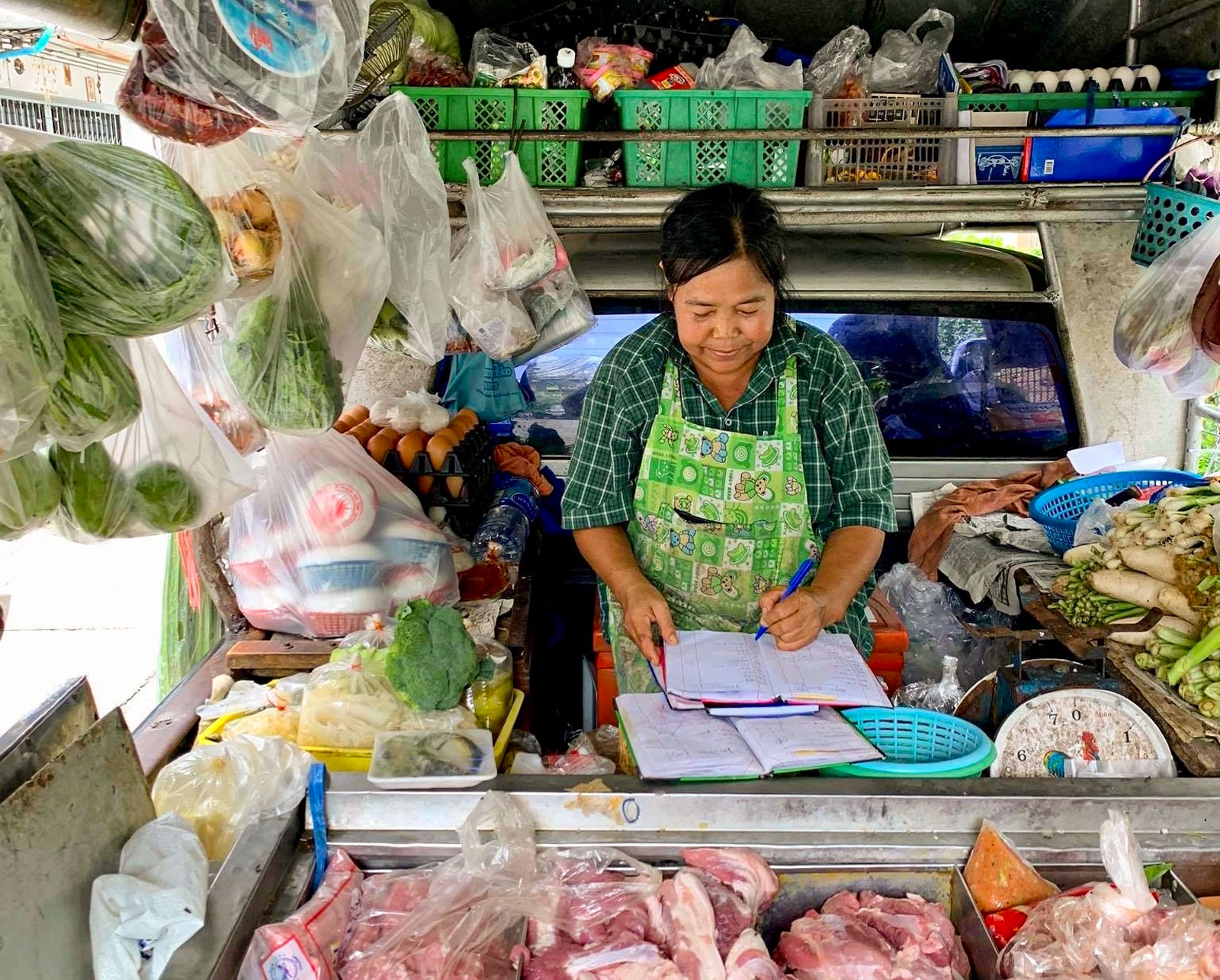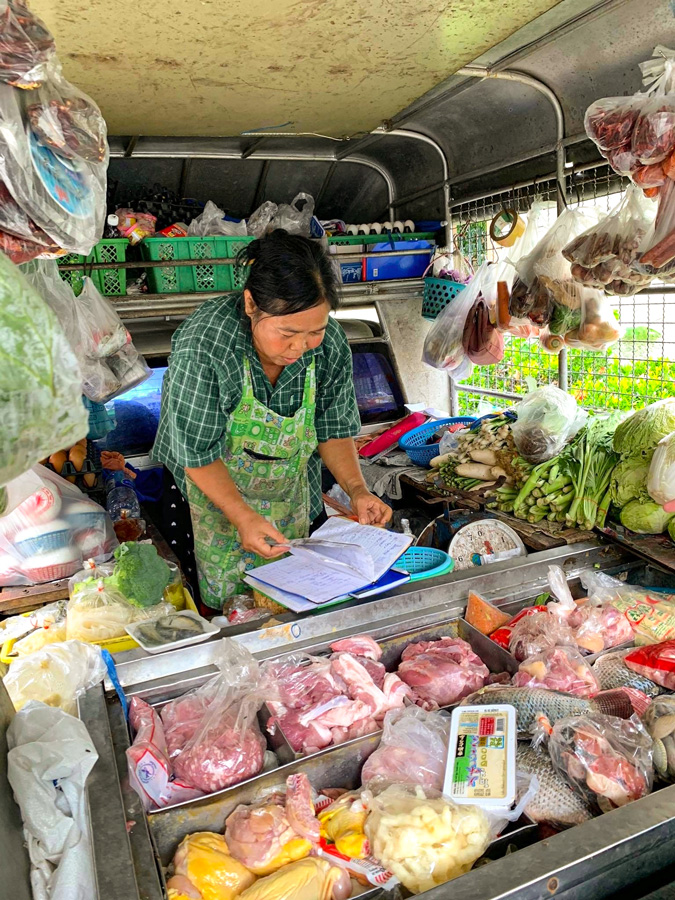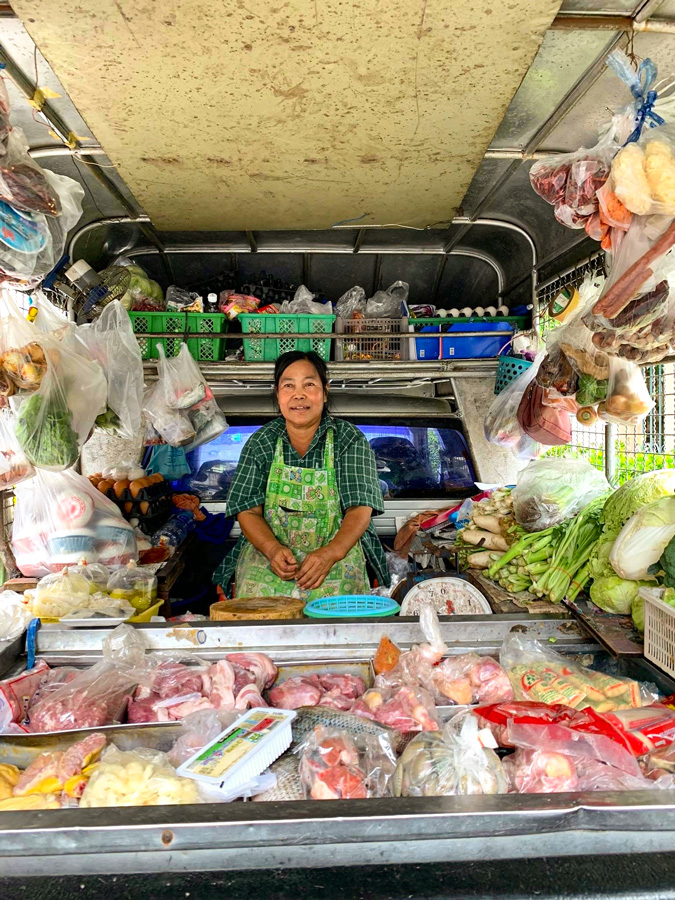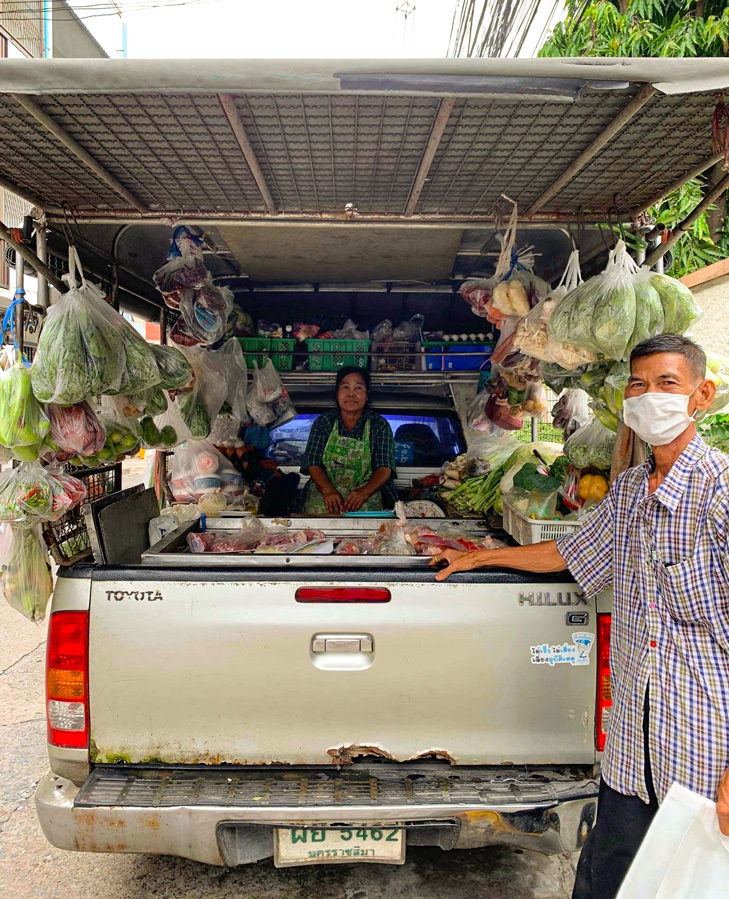“Gub Kao Krub … Gub Kao Ma Laew Krub.”
The voice reverberates out from the speakerphone announcing the mobile grocery truck has arrived, as it slowly snakes its way through the narrow Bangkok streets in the already sweltering mid-morning heat.
The converted pick-up has packages of different vegetables hanging around a metal enclosure. Inside the vehicle, a merchant surrounded by fresh produce and seasonings steers the little wet market on wheels, always on the lookout for customers new and old.
This is a pum puang truck, a mobile grocery that roams the Sois of the Thai capital’s leafier residential suburbs, where at the sound of its familiar call, residents leave their homes to buy essentials for their daily meals.
When the pandemic struck Thailand back in March, the Thai government urged the shutdown of stores while advising people to reduce social interaction in accordance with Covid-19 public health guidelines. The conditions sparked a boom in the pre-existing business of mobile neighbourhood grocers, most notably the pum puang truckers, who have traditionally carved their niche serving migrant workers and hard-to-reach neighbourhoods.
The model represents a bottom-up social innovation that on the surface may seem to lack planning. But pum puang trucks have long been adaptable to the needs of the community, and in the case of the pandemic, they have stepped up to provide uninterrupted access to fresh food – an all-encompassing concern for Bangkok’s residents in recent months.
Husband and wife Dusadee Duangtalay and Naree Duangtalay are owners of a pum puang truck in the capital’s Bangkok Noi district, a suburb lying west of the Chao Phraya river which dissects the mega-city in two.
The duo rise at dawn to buy fresh produce and trundle along their route in morning and evening shifts. Their main business grounds are near a blossoming of construction sites, a new crop of apartment complexes and transportation projects rising with the labour of a large population of foreign, mostly Laotian and Cambodian, construction workers.
“They rely on us for food,” Dusadee said. “Sometimes the workers give us a call to remind us to come because they are running out.”

Though activity in Bangkok dramatically slowed during the Covid-19 lockdown, essential services largely continued, with mostly migrant construction workers continuing to build the Thai capital’s ever-expanding skyline of apartment complexes.
It was under these conditions of limited mobility, long working hours and low wages that the pum puang truck rose to the occasion, with this ready-made business model offering some of the city’s most marginalised residents uninterrupted access to food, and even credit.
The name pum puang, meaning ‘bundles’ in Thai, comes from the copious bundles of vegetables that hang around the truck in plastic bags, but is also playfully associated with famous Thai Luk Thung singer Pumpuang Duangjan. It is also known as the vegetable truck (รถผัก) or the groceries truck (รถกับข้าว).
Pum puang trucks started to appear around the early 1990s, a time of great change for Bangkok, as an informal service to bring groceries to urban areas that were hard to reach or which lacked basic amenities.
Under the Chatichai Choonhavan government between 1986-1991, Bangkok’s population expanded by more than half-a-million people, creating a real estate boom that created new fringe areas and urban sprawl. The construction workers labouring there did not have access to wet markets, with these trucks helping to bring them fresh produce.
Later in 1991, as part of the significant political and economic reforms of the newly appointed Anand Panyarachun government, vehicle taxes were reduced, making pick-up trucks 30% cheaper. Second-hand trucks were soon available for less than 100,000 baht (about $1,500 USD at 1991 rates) as Thailand became a production base for Japanese automobile companies.
The increasing affordability of trucks, the arrival of the first convenience stores that pushed out traditional standing stores, and then the 1997 Tom Yum Kung Financial Crisis that pushed Thais to seek out new money-making opportunities, led to a flourishing of the pum puang truck industry.


For the husband-and-wife duo in Bangkok Noi, Naree sells the goods while Dusadee drives. The two, originally from Korat province northeast of the capital, moved to Bangkok in 1997 and have been running their pum puang truck business ever since.
Though the truck is similar to many of the newer, technology-driven entries that have sprouted to fill the call for mobile grocery services, a look past the bags of eggplant and chilli peppers reveals a social trust system created by entrepreneurs among Bangkok’s urban poor to serve their own communities.
Naree and Dusadee have fostered a sense of camaraderie between vendor and customer, often referring to each other by nicknames like brother and sister, with that trust enabling features like call-in requests and small loans.
Like many owners of pum puang trucks, the couple run their own credit system by jotting down customer purchases at the time of sale, but allowing their buyers to pay at a later date. For migrant workers who struggle to make ends meet and have minimal access to formal institutions, these trucks represent perhaps the only means to obtain food and cook daily meals.
The truck arrives at construction sites, helping resolve the migrant workers’ lack of transportation and gruelling working hours which leaves them with little time to purchase necessities
Naree has account books with pages dedicated to each worker at construction sites. Each day, she jots down the amount that they purchase and then collects the payment for their purchases, usually every 10 to 15 days once their salary comes out.
But the reliance is reciprocal. Dusadee and Naree depend on the construction workers as their main customers, and for the husband and wife, a site manager can act almost like the guarantor, eliminating the need for actual credit or collateral.

Dusadee explains that he talks to the construction site manager beforehand to confirm that the workers are employed at the site. The workers purchase around 50-60 baht ($1.60 to $1.90) per person each day – a large portion of the Thai daily minimum wage of around 300 baht. Food is one of the main costs of living for these workers, who send most of their salaries home as remittances.
The labourers themselves may live in shacks of tin and plywood near construction sites, dwellings that can have poor sanitation and limited potable water or electricity. The workers, who don’t typically have access to refrigeration, purchase just enough for daily consumption – often small portions of meat, vegetables and canned products. Some workers give Naree a call in advance to request ingredients in a service resembling the more formal delivery programmes seen on apps.
The pum puang truck arrives directly at the construction sites, helping to resolve the migrant workers’ lack of transportation means and gruelling working hours which leaves them with little time to purchase necessities.
“We visit more than seven construction sites in a day,” Dusadee said.
I’ve been able to support my kids’ education, they just graduated from university, doing this job for 20 years.
Beyond selling fresh produce to doorsteps, these trucks have long reflected how those who live on the less-glamorous Sois outside the attention of big business can innovate during difficult times.
Once catering mostly to Bangkok’s invisible, the pandemic has brought increased attention to the important role of pum puang trucks in Thai society as the majority of people struggled with social isolation, receiving a glimpse inside the struggles of food access and security.
So while pum puang trucks may be increasingly outshone by a plethora of slick food delivery apps on offer, for Naree and Dusadee, as well as the many customers that rely on them, their essential service is simply a way of life.
“Although the hours are long, it gives us more freedom than other jobs. I enjoy it,” Naree said. “Doing this job for 20 years, I’ve been able to support my kids’ education, they just graduated from university.”


